As electric vehicles (EVs) become more common, charging stations are more important than ever. In 2024, understanding how EV charging stations work is crucial for every driver. Whether you’re a new EV owner or considering making the switch, this guide will help you navigate the world of EV charging.
Charging stations are the backbone of electric vehicle travel. Understanding EV charging stations means knowing where to charge, how fast you can charge, and what it will cost. Let’s explore the types of charging stations, their differences, and how to make the best choice for your needs.
Types of EV Charging Stations
There are three main types of EV charging stations: Level 1, Level 2, and DC fast charging. Each type offers different charging speeds and is suited for different situations. Understanding EV charging stations starts with knowing the options.
- Level 1 Charging
Level 1 charging uses a standard 120-volt outlet, just like the ones in your home. This is the slowest charging option. It adds about 3-5 miles of range per hour of charging. While this works for overnight charging at home, it’s not ideal for long trips. Understanding it means knowing that Level 1 is best for people who don’t drive long distances daily. - Level 2 Charging
Level 2 charging uses a 240-volt outlet, which is the same as your dryer or other large appliances. It charges much faster than Level 1, adding 15-30 miles of range per hour. Most public charging stations and home chargers are Level 2. For everyday use, this is the most practical option. Understanding EV charging stations includes recognizing that Level 2 chargers provide a good balance between speed and convenience. - DC Fast Charging
DC fast charging (or Level 3) is the fastest option available. These stations use direct current (DC) to charge your EV at lightning speeds. They can add up to 80% of your vehicle’s battery in 30 minutes. This makes them ideal for road trips or quick stops when you’re in a hurry. However, not all EVs can handle fast charging, so understanding EV charging stations means checking if your vehicle supports it.
Locations of EV Charging Stations
Finding a charging station is easier than ever in 2024. Charging networks are expanding rapidly, with stations available in public places like shopping centers, parking lots, and highway rest stops. Understanding it includes knowing where to find them when you’re on the go.
- At Home Charging
Most EV owners charge their vehicles at home. Installing a Level 2 home charger can fully charge your car overnight. Understanding EV charging stations means knowing that home charging is convenient and cost-effective, especially if you have access to cheaper electricity rates during off-peak hours. - Public Charging
Public charging stations are widely available in cities, suburban areas, and even rural regions. Apps like PlugShare or ChargePoint help drivers locate nearby stations. Some grocery stores, malls, and parking garages offer free charging to attract customers. Understanding means knowing that these options are growing, and many offer flexible payment methods. - Highway Fast Charging
For long road trips, fast charging stations along highways are crucial. Networks like Tesla Superchargers and Electrify America provide fast charging to keep your journey going. Understanding EV charging stations also includes planning ahead, especially in areas where charging infrastructure may be less developed.
Costs of Charging an EV
One of the biggest concerns for new EV drivers is the cost of charging. Understanding EV charging stations involves knowing the factors that affect how much you’ll pay to charge your vehicle.
- Home Charging Costs
Home charging is typically the most affordable option. The cost depends on your local electricity rates, but it usually ranges from $0.10 to $0.30 per kilowatt-hour (kWh). Charging at home costs less than filling up a gas tank. Understanding EV charging stations at home means knowing how to take advantage of off-peak electricity rates to save money. - Public Charging Costs
Public charging station costs vary depending on the network and location. Some stations charge per kWh, while others charge per minute. Fast chargers tend to cost more than Level 2 chargers, but they’re also much quicker. Many public stations offer memberships or subscription plans that provide lower rates. Understanding EV charging stations includes knowing that some public chargers offer free or discounted charging for certain users. - Subscription Plans
Several charging networks, such as ChargePoint and EVgo, offer subscription services. These plans often reduce the cost per charge or provide unlimited charging for a flat monthly fee. If you frequently use public charging, subscribing can help you save money. Understanding means includes knowing which networks offer the best deals in your area.
How to Find the Right Charging Station
Finding the right EV charging station is easier with the right tools. It means using apps and networks to make your charging experience seamless.
- Use Charging Apps
Apps like PlugShare, ChargePoint, and Tesla’s network app help you locate nearby charging stations. They provide real-time availability, prices, and user reviews.It means taking advantage of these tools to plan your charging stops. - Plan for Charging Times
While fast chargers are convenient, they aren’t always necessary. If you have time, Level 2 charging at a shopping center or hotel can save you money. It means balancing convenience with cost when planning your trips. - Network Memberships
Joining a charging network can simplify your charging experience. Many networks offer perks like priority access or discounted rates for members. Understanding EV charging stations also includes exploring network memberships if you rely on public chargers.
The Future of EV Charging Stations
As we move further into 2024, understanding EV charging stations involves staying informed about new developments. The future of charging includes faster speeds, more widespread availability, and the integration of renewable energy sources.
- Ultra-Fast Charging
New technology promises even faster charging times. Ultra-fast chargers, which are in development, could fully charge a vehicle in under 10 minutes. This would make long trips even more convenient for EV drivers. Understanding EV charging stations means keeping an eye on these advancements as they roll out in the coming years. - Wireless Charging
Another exciting development is wireless charging. This technology allows EVs to charge without plugging in. Instead, the vehicle parks over a charging pad, and electricity transfers wirelessly to the battery. While still in its early stages, wireless charging is set to become a reality for many drivers. Understanding EV charging stations will soon include this wireless option. - Solar-Powered Charging
As the push for renewable energy continues, solar-powered charging stations are becoming more common. These stations use solar panels to generate electricity, reducing the environmental impact of charging. Understanding EV charging stations means knowing that clean, sustainable energy is the future.
Conclusion
As electric vehicles continue to rise in popularity, understanding EV charging stations is essential for every driver. From choosing the right type of charging station to finding the best locations, this guide covers everything you need to know in 2024.
Whether you’re charging at home, using a public station, or planning a long road trip, staying informed will make your EV experience smoother. Understanding EV charging stations means knowing the best ways to charge your vehicle, control costs, and take advantage of future innovation.




